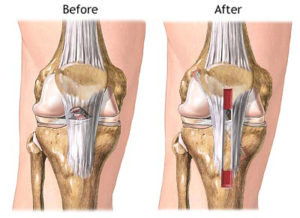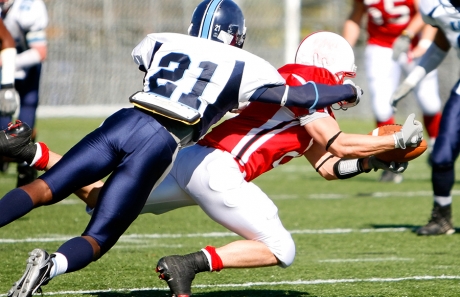In ACL reconstruction or repair, an orthopedic surgeon restores the function of the normal anterior cruciate (KROO-she-ate) ligament of the knee. This ligament is important in stabilizing the knee in athletics and day-to-day activities. The term ACL is an acronym for the anterior cruciate ligament, and easier to pronounce.
In ACL reconstruction or repair, an orthopedic surgeon restores the function of the normal anterior cruciate (KROO-she-ate) ligament of the knee. This ligament is important in stabilizing the knee in athletics and day-to-day activities. The term ACL is an acronym for the anterior cruciate ligament, and easier to pronounce.

Ligaments are strong bands of tissue that connect one bone to another. The ACL, one of two ligaments that cross in the middle of the knee, connects the thighbone (femur) to the shinbone (tibia) and helps stabilize the knee joint.
ACL injury most commonly occurs during sports that involve sudden stops and changes in direction — such as basketball, soccer, football and volleyball. ACL injuries typically occur in non-contact events on the sporting field. They can also be the result of workplace injuries and traumas such as motor vehicle accidents.
In the past, a torn ACL would mean the end of high level athletic activity for a prolonged period of time and possibly permanently. Today’s minimally invasive arthroscopic reconstruction followed by aggressive rehabilitation can restore the knee’s stability and function.
Not everyone who tears an ACL requires reconstruction. Sedentary people who forgo sports that involve a lot of quick stops and changes in direction usually recover well with conservative treatments and physical therapy. Bracing is also an option.
An orthopedic surgeon may recommend ACL reconstruction if:
- You are an athlete and want to continue in your sport, especially if the sport involves jumping, cutting or pivoting
- More than one ligament or the cartilage in your knee is injured
- You are young and active
- The injury is causing instability in your knee during activities of daily life, such as stair climbing
What to Expect During ACL Surgery
ACL reconstruction is performed on an outpatient basis under anesthesia. The ACL is replaced with a piece of tendon from another part of the leg or from a tissue bank.
Orthopedic surgeons use an arthroscope, a small fiber-optic viewing instrument made up of a tiny lens, a light source and video camera, to perform ACL repair.
The orthopedic surgeon creates a tiny 5mm puncture in the joint space of the knee – about 1/4 of an inch – called a portal. Additional small punctures are made for the insertion of surgical instruments. These punctures result in tiny scars, which become unnoticeable, providing direct access to most areas of the knee joint.
The orthopedic surgeon views the procedure on a large screen monitor as the graft is positioned and then secured with screws or other fixation devices.
In an acute injury, surgery is usually delayed until muscle strength and knee mobility has been improved with physical therapy. People who go into surgery with a stiff, swollen knee often have problems regaining full range of motion after surgery.
What to Expect After ACL Repair
The patient returns home on the day of surgery and immediately begins the rehab process. Before going home, patients practice walking with crutches. To reduce swelling and pain in the days immediately following surgery, the R.I.C.E. model of self-care is followed at home:
- Rest. Use crutches to avoid weight bearing on the knee.
- Ice. Applying ice for 20 minutes every two hours when awake will help reduce swelling and ease pain.
- Compression. An elastic bandage or compression wrap keeps the knee immobile and supported.
- Elevate. Elevating the leg to heart level reduces swelling and pain.
The orthopedic surgeon will also prescribe medication to help manage pain. Physical therapy strengthens the muscles around the knee and improves flexibility. Most patients can expect a return to full function within 6 to 9 months. Athletes can often return to their sports after 6 to 12 months.
Choosing an Orthopedic Surgeon for ACL Repair
To ensure the best possible outcome, it is important to choose a surgeon experienced performing minimally invasive ACL repair.
Good communications between patient and surgeon is critical. You should be comfortable asking your doctor questions, sharing your concerns, and feel that your surgeon takes the time to respond fully and completely. Together, you and your orthopedic surgeon can create the best plan of care to help return you to normal activities as soon as possible following ACL repair.

